

“A great man, whose utterances still have their lessons for the world, with wholesome influences for all plastic minds, should be studied in a complete, correct, and critical edition.”
One major goal is to provide the means for the Peirce Edition Project not only to resume the work of publishing a reliable and trustworthy scholarly edition of Peirce’s voluminous and extraordinary writings, but to do so moreover without any interruption caused by economic disturbances.
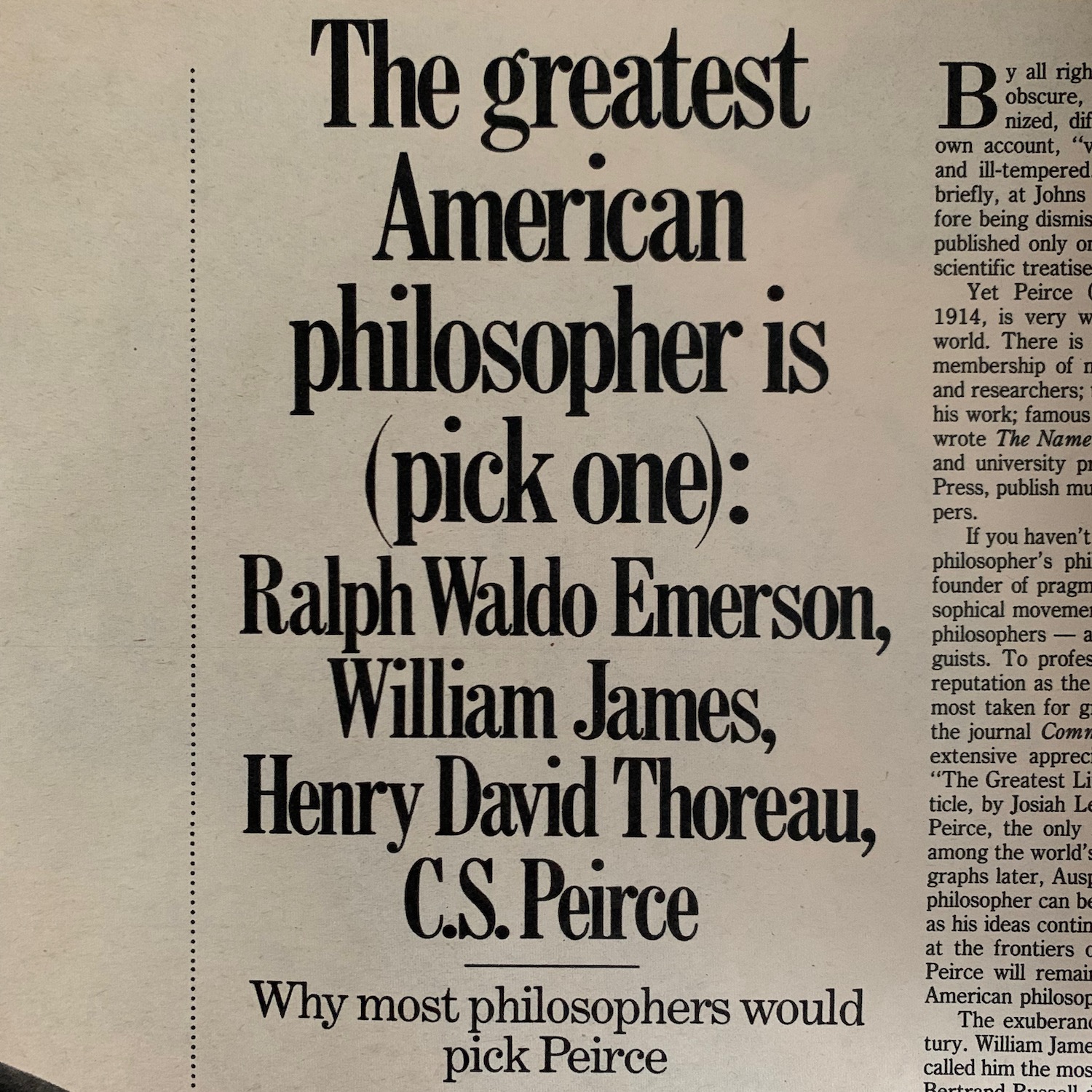 The stakes for posterity could not be higher. The United States of America MUST publish and make available the works of this native genius, the most fundamental thinker since Aristotle and Leibniz. If there has ever been a human mind closest to finding out the logic of reality and the method for conducting such an inquiry, Peirce is that mind. His findings have global significance. Scholars in every discipline are making use of them. The need for a systematic and uninterrupted edition has never been greater.
The stakes for posterity could not be higher. The United States of America MUST publish and make available the works of this native genius, the most fundamental thinker since Aristotle and Leibniz. If there has ever been a human mind closest to finding out the logic of reality and the method for conducting such an inquiry, Peirce is that mind. His findings have global significance. Scholars in every discipline are making use of them. The need for a systematic and uninterrupted edition has never been greater.
The left panel lets you navigate through six informative panes: Need for a Permanent Endowment, Why 15 Million Dollars?, Peirce’s Relevance for Posterity, Campaign Strategy, How to Donate, and Campaign Supporters.
[Title page of an article by D. C. Denison published in the Boston Globe Magazine on 10 March 1985, beginning p.9. ➔]
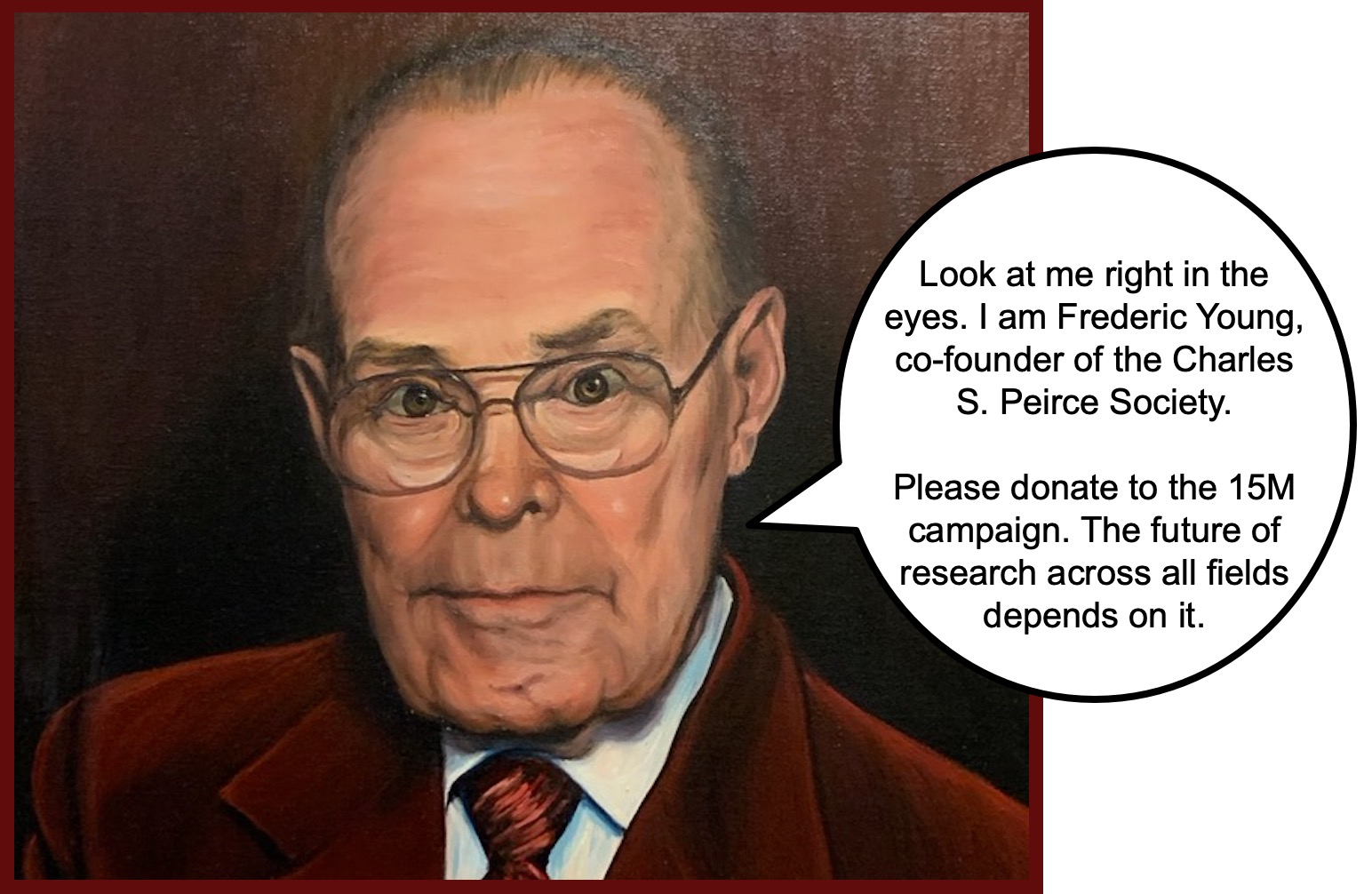
This is no idle boast. Already in late 1877 British mathematician and philosopher William K. Clifford had told Edward L. Youmans that Peirce was “the greatest living logician, and the second man since Aristotle who has added to the subject something material, the other man being George Boole.” A year later, American psychologist G. Stanley Hall declared that Peirce’s “Illustrations of the Logic of Science” “promise[d] to be one of the most important of American contributions to philosophy.” German logician Ernst Schröder went further when, in 1896, he told Paul Carus that “the fame of Charles S. Peirce will radiate equal to that of a Leibniz or an Aristotle in all future millennia.”
Those international pronouncements were made many years before Peirce’s mature writings across the first decade of the twentieth century, notably on pragmatism, semiotic logic, graphical logic, and metaphysics. In 1945, ten years after the publication of the sixth volume of the Collected Papers, a host of prominent American philosophers had reached the same conclusion when evaluating Peirce’s contributions to philosophy comparatively to others, as reported by Frederic Harold Young, the principal founder of the Charles S. Peirce Society.
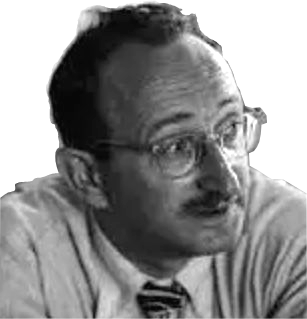
Sidney Hook, then Professor of Philosophy at New York University, wrote:
“More than any one man in the history of human thought, Charles Peirce pointed the way to bridging the age-old dualism between things and human thought. This he did in his epoch-making conception of man as a sign-using animal, and his interpretation of the life of mind as the life inherent in symbols. It is by the use of symbols that man as a piece of nature becomes human; and it is through man’s activity directed by symbols that nature becomes meaningful and reasonable. The rich implications of Peirce’s fundamental insight are yet to be explored. Today he is just as much the philosopher’s philosopher, just as much the pioneer of a second Copernican revolution in thought (one more genuine than Kant’s) as he was when his meteoric genius first flashed across American skies.”
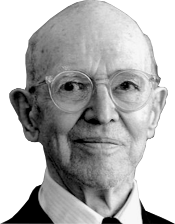
Charles Hartshorne, then Professor of Philosophy at the University of Chicago, and co-editor with Paul Weiss of Peirce’s papers, knew well what he was talking about:
“Besides being a great logician, Peirce was a great mathematician—according to a foremost English authority [James Joseph Sylvester] who was at Johns Hopkins with him, a ’much greater’ mathematician than his father, Benjamin Peirce, who had been the leading mathematician of his day.
“In general philosophy, beyond logic, Peirce wrote brilliantly in several fields. And here, too, his views were revolutionary for his own day, and such as fifty years later came to be widely seen as important. The most ambitious and complete philosophy of our day, that of Whitehead, is more fully anticipated by Peirce, probably, than by anyone of his time, unless, perhaps, William James is an exception.
“ . . . Other important doctrines are his classification of signs, his theory of the three categories, his synechism and tychism (the first and in some respects still the best efforts to do justice to the ideals of continuity and chance in philosophy), and his evolutionary ’agapism.’
“ . . . Peirce, so far as I can find, combined more knowledge of exact science and the history of ideas with more inventive genius in philosophy than any man of his time. . . . It was the first time since Leibniz that there had been such a phenomenon, a mathematician who was a logician and a physicist and a chemist and a metaphysician. He even did work in experimental psychology.”
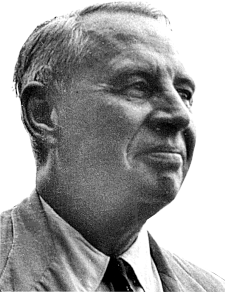
F. C. S. Northrop, then Professor of Philosophy at Yale University, came independently to the same conclusion:
“Charles Santiago [sic] Peirce ranks with Willard Gibbs as one of the greatest systematic theoretical and creative minds this country has ever produced. Not only did he formulate certain basic ideas in technical, mathematical, and symbolic logic, but also he laid the technical foundations of the philosophical movement known as pragmatism. . . . For all their technical precision and originality, these doctrines of Peirce’s grew out of a thorough understanding of the works of the past, especially those of Immanuel Kant. In the field of empirical logic and scientific method similarly he combined a thorough understanding of the formal mathematical and deductive side of scientific and philosophical procedure with an informed emphasis upon its empirical inductive and pragmatic aspects. When one compares him with previous minds in the history of western thought, one thinks of Aristotle and Leibniz.”
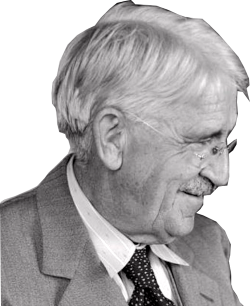
The great John Dewey, then recently retired from the Philosophy Department of Columbia University, had studied Peirce’s Collected Papers minutely and admitted the fact:
“C. S. Peirce was ahead of his times intellectually by more than a generation. Psychology and Philosophy are even now only slowly catching up, beginning to understand what he wrote. I note the following points:
(1) What is called the ‘external world’ is not primarily a matter of knowledge but of that ‘two-sided’ direct interaction of organic-environmental conditions that occurs in ‘effort-resistance’, the effort side being called ‘action’, while the influence of the resisting conditions determine the ‘perceptual’ side. Peirce never separates ‘motor’ and ‘sensory’; neither is primary, though we may distinguish phases in which one or the other is dominant. Contemporary psychology is just beginning to take account of the full force of this position.
(2) What is called thought is a matter of that form of signs that constitutes languages. Thought is language, and language is thought, not an expression or clothing for it. Since language is a mode of communication, ‘logic is rooted in the social principle’—Peirce’s own words.
(3) Language elevates habit, otherwise physical and physiological, to the plain of acknowledged continuity, generality, or reasonableness.
(4) There is no fixity nor finality in the process. Its nature is growth, indefinite and continuous. The continuity of growth is our chief ground for hope with respect to the future of man.”
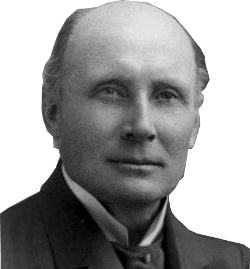
Renowned process metaphysician Alfred North Whitehead shared the same thought:
“Peirce was a very great man, with a variety of interests in each of which he made original contributions. The essence of his thought was originality in every subject he taught. For this reason none of the conventional labels apply to him. He conceived every topic in his own original way.”
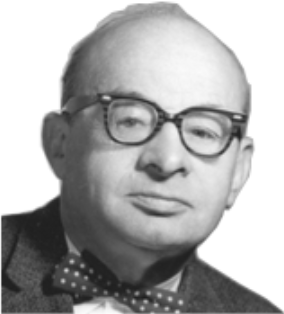
Paul Weiss, then Professor of Philosophy at Bryn Mawr College, and co-editor with Hartshorne of Peirce’s Collected Papers expressed this assessment in 1939 on the hundredth anniversary of Peirce’s birth before the American Philosophical Association at Columbia University:
“I am not concerned with praising Peirce—that would be impertinent—but in doing honor to him on this hundredth anniversary of his birth. . . . Peirce was a metaphysician as well as a logician, a realist as well as a semiotician, a speculative thinker as well as an experimental scientist, an idealist as well as a naturalist, and a pragmatist who had a theory of ethics which acknowledged a fixed and universal ideal. These were not for him, and they ought not be for us, inconsistent positions. Truth is rich and complex enough to accommodate both the abstract and the concrete, the temporal and the eternal, the general and the specific, the absolute and the relative, the probable and the certain. Peirce was a philosopher precisely because he saw that these different factors were facets of one encompassing truth and reality, and that philosophy was not a point of view but a study of that which embraces all points of view.”
Frederic H. Young also quoted from a letter Paul Weiss had sent him:
“Charles S. Peirce is one the great minds of the 19th century. He is one of the most unusual, original and erudite men born in America. He is the founder of pragmatism—America’s great contribution to philosophy; he is the founder of the modern theory of signs; he is one of the founders of modern logic; he was one of the very few in the history of thought who was at home equally in the laboratory and the library, in ancient and modern thought, in English and German culture. He influenced Royce, James, Dewey, Cohen, his editors, and a host of other thinkers in this century. Almost entirely ignored in his day, he is now becoming better and better known as one of America’s great contributions to civilization.”
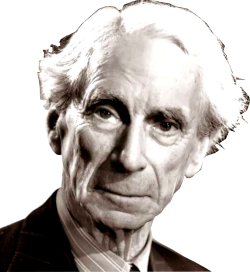
Bertrand Russell himself had occasion to appraise Peirce as a philosopher more fairly than he had done earlier in his life, in the foreword he wrote to James K. Feibleman’s An Introduction to Peirce’s Philosophy Interpreted as a System in 1946.
“Peirce himself, like Leibniz, gave to the world only fragments of his system, with the result that he has been very thoroughly misunderstood, not least by those who professed to be his admirers. I am—I confess to my shame—an illustration of the undue neglect from which Peirce has suffered in Europe. . . . Peirce’s pragmatism (or pragmaticism as he came to call it) is a very different doctrine from those of James and Schiller and Dewey, and one not open to the same criticisms. . . . Peirce was a man of tremendous energy, producing a multitude of ideas, good, bad, and indifferent. He reminds one of a volcano spouting vast masses of rock, of which some, upon examination, turn out to be nuggets of pure gold. . . . Peirce was undoubtedly a great philosopher, and it is important that he should receive the respect that he deserves.”

The Peirce Edition Project began operation at IUPUI in 1975–1976 (see our history). At the time of this writing (March 2023), IUPUI (now IU Indianapolis) has hosted our research center for nearly 48 years. The Project moved from the campus to the IU School of Liberal Arts in 1983, and thus the School has hosted us for 40 years, at considerable cost. That span of time is well worth appreciating.
Throughout those decades, PEP occupied four distinct campus locations: its initial lodgings were within the “Old Library” — today’s Joseph Taylor Hall. When PEP became a unit of SLA, it moved to a suite of offices on the top floor of the School’s building: Cavanaugh Hall, rooms 539 to 545, from 1983 to 2004. After the Institute for American Thought was created in 2003 (under Dean Herman Saatkamp, with PEP Director Nathan Houser as its founding director), the Project moved in 2004 to the basement of the Education/Social Work building along with the other two editions, Santayana and Douglass. The Center for Ray Bradbury Studies, founded by PEP Textual Editor Jonathan Eller, was added soon thereafter.

That basement gave us all 8,000 square feet, half of which was occupied by the Peirce Project. The size was adequate for our growing footprint: the large Max Fisch Library with its several deposits, our multiple archives, and forty years of accumulated resources. The rent associated with that space, arranged by Dean Saatkamp with the campus, was low and not a matter of budgetary concern for the School. At some undetermined time, the campus revised its space-renting formula and began to charge the School $25 per square foot, thus $200,000 a year, unbeknownst to School officers.

Yet the basement was beset by poor heating and ventilation, regular water leaks from rusted pipes in the ceiling and from walls in rainy days, and occasional flooding. The School decided to repatriate the editions to Cavanaugh Hall, which was easy enough for Santayana and Douglass given their smaller footprints, but quite intractable when it came to the Peirce Project. A sudden mold contamination that spread in the basement in the fall of 2021 due to a combination of high humidity and excessively cold air-conditioning forced the Project to evacuate precipitously. In the end, we lost four-fifths of our research and library space. The larger part of the Max Fisch library was relocated in the Law School Library. PEP is now squeezed inside a small suite of offices on the second floor of Cavanaugh Hall (CA 213), plus the director’s more spacious office on the fifth floor, with enough room for 18 full bookcases and a few file cabinets (CA 513). [Below: partial panoramic view of Max H. Fisch Room]

The School of Liberal has been beset by a growing financial crisis for well more than a decade. It has been in continual deficit due to a conjunction of factors: competition from Ivy Tech Community College, the COVID pandemic, sharp fall in student enrollment, drop in state appropriations, and increased tax levy by university and campus administrations. The impact on the Peirce Project has been continual personnel attrition. One by one our transcribers and proofreaders were let go or pressured to retire. Retiring editors were not replaced. Hires were frozen.
The last straw occurred in October 2022 when the Dean decided that all non-tenure-track personnel and non-grant- or endowment-funded personnel in research centers would be cut off by the end of the fiscal year or the end of their funding. This led immediately to the disintegration of the Institute for American Thought, the common umbrella for the School’s four scholarly editions: the Santayana Papers, the Center for Ray Bradbury Studies, the Frederick Douglass Papers, and the Peirce Project. The IAT now only exists on paper, dormant if not dead, the way opossums subsist under attack.
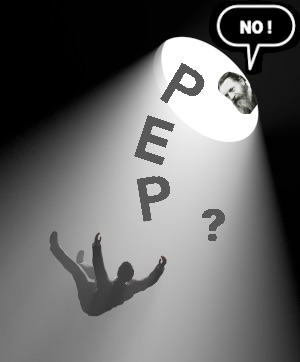
The Peirce Project has faced all sorts of crises in the past, but never the abyss that has now opened in front of us. The Dean explained that if we wanted to retain our employees, we had to “buy” them. Long has gone the time when the university was a non-profit institution. Nowadays, even non-professional schools—such as Liberal Arts and the School of Arts and Design—are expecting their faculty to become entrepreneurs and reimburse the institution multiple times their salaries. The humanities and the arts, however, conduct research and creative activities that are meant to produce, not raw income, but new knowledge, deepened understanding, and innovative aesthetic experiences. Yet the university administration wants every square foot of the space we occupy to produce 25 dollars a year. It is our misfortune that money does not grow out of floor tiles.
Should the Project lose its remaining employees and should the director become the only member of his own personnel, then our years-long efforts to develop a decentralized online platform to produce the edition, supported by a prestigious NEH digital-humanities grant, would be annihilated. The reconstruction of the Peirce Project throughout 2022 would have been pointless. Our large, specialized library, our archival collections, our research resources, all of that on which so many articles, theses, dissertations, and books depend for their making and scholarly success, would no longer be accessible. Our expertise would go to waste. The work and career of plenty of prominent scholars who devoted their lives to Peirce research will have their value negated. Peirce scholarship worldwide across multiple disciplines will stagnate for lack of a standard and trustworthy critical edition. Crucial questions will fail to be formulated or failed to be answered for lack of a guiding methodology.

All of those consequences must and can be avoided as a matter of ethics and logic. The reputation of no less than the United States is at issue. That Charles Peirce counts as one of the most momentous thinkers in its history, if not even the most when considering the next millennium, is the general consensus. That the US ought to care about the best of its intellectual legacy goes without saying. Plenty of scholars, institutes, societies, associations, and universities abroad are wondering whether the US will take care of Peirce’s legacy and fund the scholarly edition of his writings. Our fundraising campaign is designed to avoid that national shame and turn its prospect into national pride.
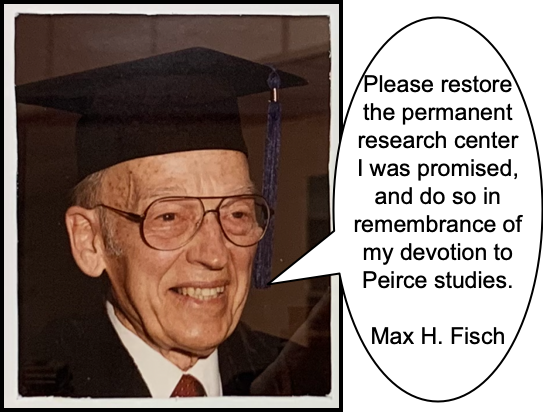
The background of our plan is linked to the historical fact that, back in 1986, Peirce scholarship’s founding father Max H. Fisch agreed to donate his papers and library to the Project following a specific assurance made to him by the university at the time. Here is an excerpt from a letter Fisch wrote to Ms. Helen Elizabeth Peirce Prince (aka “Betsy”), a grandniece of Peirce’s:
“Indiana University has decided to make the Peirce Edition Project a permanent research center, continuing on beyond our 20th volume, and extended to include other members of the Peirce family: his father Benjamin, his grandfather Benjamin, his brother “Jem” (James Mills), and your grandfather Herbert. We already have the papers and the philosophical part of the library of Charles Morris, an important follower of Charles Peirce in semiotics. I am leaving my own library to this new center, and it is being catalogued and evaluated at the present time. (My professional correspondence and research files are included.) If you are still undecided about your grandfather’s books and papers, may I suggest that you consider the Peirce Project. . . . I personally would be very pleased if your grandfather’s collection were deposited here, and the director of the Project and the Dean of our School of Liberal Arts would be delighted with such an addition to our resources. They assure me that it would be kept separate and properly cared for, and made accessible only to qualified scholars and students.”
The highest level of the IUPUI administration was copied that message and replied gratefully, hoping that Mrs. Peirce Prince would consider Max’s suggestion favorably, and thanking Max for deciding to donate his library to the research center. They assured him that his papers would be preserved “as an invaluable instrument of scholarly research,” “a foundation stone for a very significant program,” and that IUPUI was committed to that goal.
That commitment, perhaps predictably, would not survive subsequent changes of administration and losses of institutional memory. But the argument for permanence had been in everyone’s mind at the time: NOAA installed the Peirce Geodetic Marker on campus ground in 1987 on that premise; the Peirce Project provided great prestige to the institution and could be counted on as an instrument of rigorous scholarship and research with plenty of positive ramifications in several branches of inquiry for the long haul. That proved to be an excellent and well-rewarded calculation for many years.
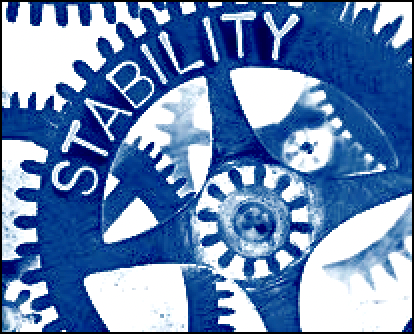
Now that the good times are over, it has become clear that only a sizable permanent endowment would provide the desirable solution. In essence, a large endowment would provide annually the revenue that the Project needs to maintain a team of scholars, editors, transcribers/proofreaders at work continually and independently of economic and budgetary crises. With a permanent endowment, the Project would never have to waste time applying for improbable grants. The Project could also more easily attract excellent personnel with outstanding credentials, attracted by both the prestige and the stability of the positions, embedded in a supportive academic environment open to intramural and extra mural collaborations. The editorial mission would thus been taken care of optimally.
Moreover, with a permanent endowment the Project would also become a stable research center, attracting visitors and facilitating their research, organizing disciplinary, transdisciplinary, and multidisciplinary conferences and seminars. The research center would also be able to take better care of its collections, giving them the benefit of state-of-the-art preservation while also cataloging them and making them more readily available electronically.
For all those reasons, a permanent endowment is what we seek. We invite all interested parties to make donations, small or large. The larger, or the more frequent, the better. All donors will be recognized except if they request anonymity. Very large donors will get special recognition with naming rights that will celebrate their generosity and redound to their reputation across the ages.
Naming rights extend to titled distinguished professorships and editorships. The name of the largest donor may be attached to the research center itself, thus perpetuating that donor’s legacy and memory forever with the enduring gratitude of generations.
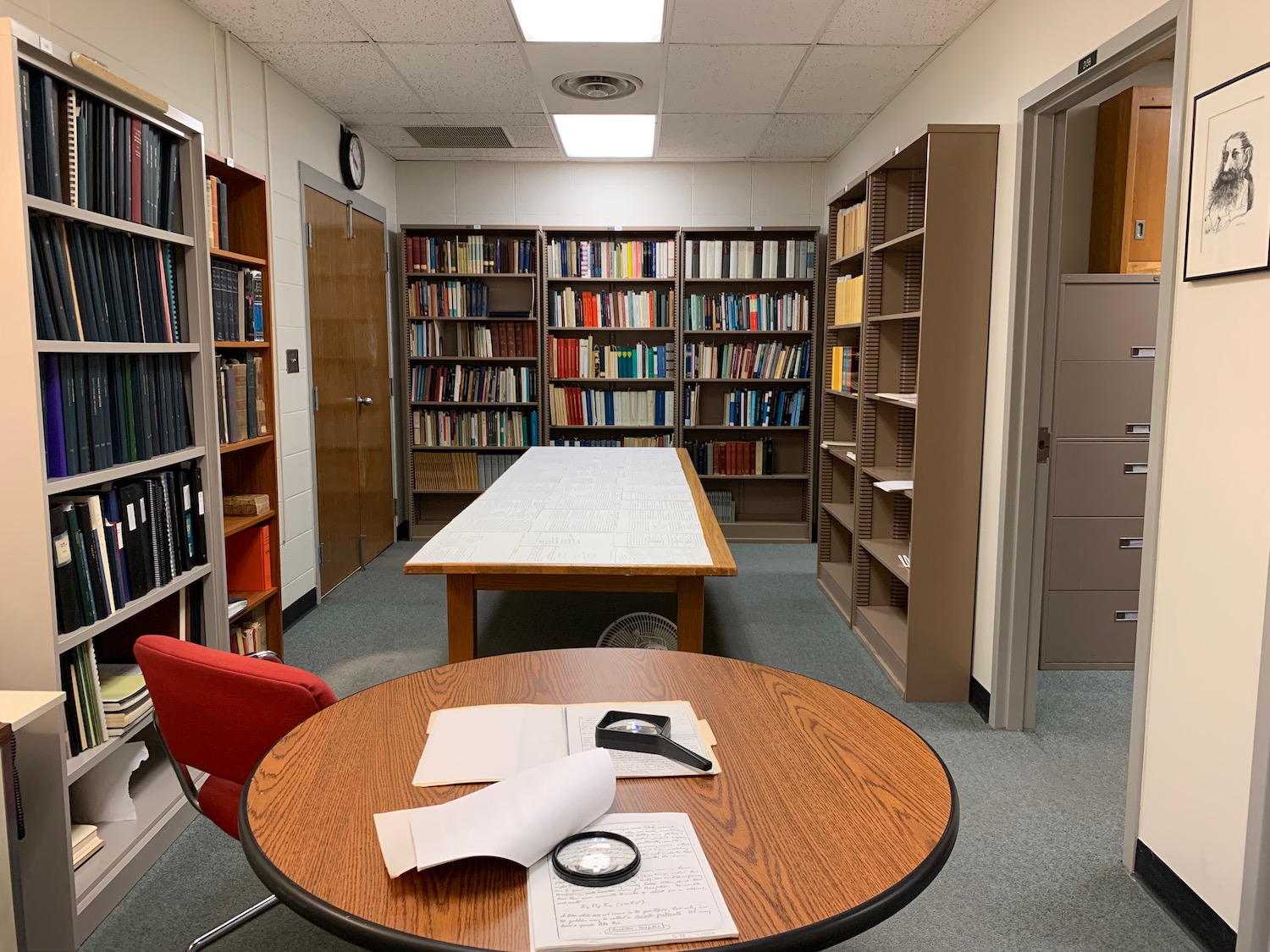
Entrance area and main research room in the Peirce Project’s new research center in CA 213
This page will explain why it is that Peirce’s methods of inquiry, logical insights, metaphysical theories, forays into cognitive science, nomenclatures of sign structures, and so on, matter so much for the future of research in many disciplines. Investing in the Peirce edition is investing in future research across the board. This is the principal reason that should serve as the engine of the fundraising campaign. Cutting edge research in artificial intelligence stands to gain crucial insights when conceiving advanced neuronal algorithms capable of conceiving genuine hypotheses. Theoretical physics stands to understand far more robustly not only the special kinds and modes or realities they are grappling with every day, but also the role of time in their physics. Biology stands to gain far better insight into the passage from the atomic and molecular level to that of the living matter. The stakes they have in Peirce are very high. The keys are in Peirce’s unpublished manuscripts.
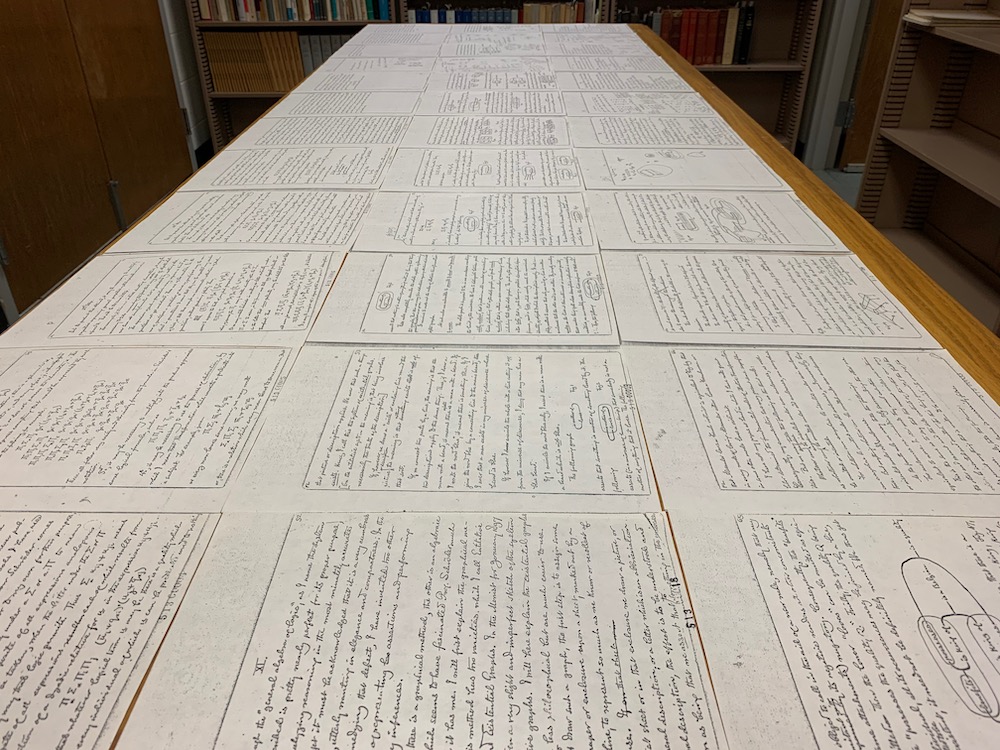
The research table covered with sheets from MS R513, which treats of logical algebra and logical graphs.
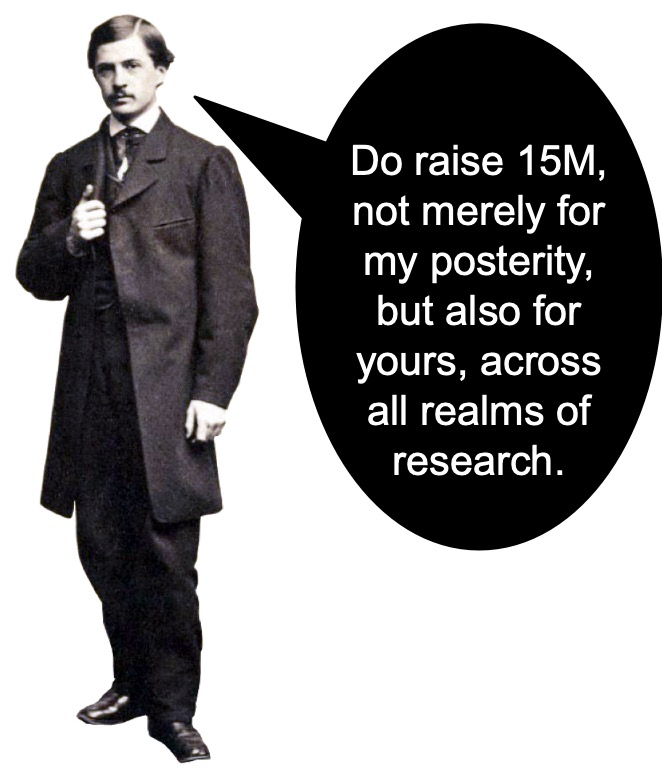
For all of our resources to remain of service to Peirce scholarship worldwide in all of its multidisciplinary aspects, including facilitating doctoral and postdoctoral research, and to revive the production of the fundamentally necessary chronological and critical edition we all need, we must find $675,000 or more every year. Since the School maintains the Director’s own tenured position, the latter’s salary will likely remain in place, and it makes sense for the School to continue investing in at least that one position.
The calculation is that, in average, a $15,000,000 endowment will generate $675,000 annually (4.5%), sometimes more, sometimes less. That annual income would allow PEP to pay the following salaries (fringes included) and other items:
(a) an excellent programmer/software engineer (Ph.D. in cloud computing with several years of experience) to develop, maintain, update, and upgrade our platform of production (STEP: Scholarly Text-Editing Platform): $110,000;
(b) one scholar with a PhD on Peirce and an aptitude for minute editing that will be groomed for several years in all the arcana of our complex workflow notably to succeed the current director within ten years (an endowed tenure-track position): $85,000+;
(c) a textual editor in charge of critical editing (100% effort; PhD in English or similar—an endowed position, $85,000;
(d) a typesetter/layouter in charge of typesetting each pass of each document iteratively both for the print and the on online product—that employee must have XML encoding and XSLT experience (100% effort; degree in digital humanities or similar—an endowed position, $85,000;
(e) two lower-level positions to transcribe, encode, and proofread manuscripts (each en endowed position, $65,000 X 2 = $130,000);
(f) two graduate students for all kinds of tasks (50% effort, with tuition fees and insurance: 2 x $36,000 = $72,000);
(g) operational costs (computers, phones, office supplies, travel to archives and conferences, print and digital publication costs, software, cloud servers, etc.): $60,000; and
(h) research center space: $48,000.
Total: $675,000. Excess endowment revenue will be reinvested to yield the cost of promotions and annual raises, as well as to sponsor young visiting researchers occasionally.
When STEP goes online, scholars from many places will be able to collaborate to the enterprise by providing annotations, TEI-XML encoded transcriptions, and so on, while being credited for their work after vetting. But even with STEP we need the core team at IU Indianapolis to conduct proofreading and other sorts of checking and corrections; to supervise the entire workflow locally and online; to monitor inquiries; to welcome and guide/supervise visitors; to organize seminars and conferences.
The members of the fundraising board will be listed here when the board is fully constituted. Those members will be officially appointed with distinct duties and responsibilities. They will be habilitated to contact prospective donors and campaign in the name of the Peirce Edition Project.
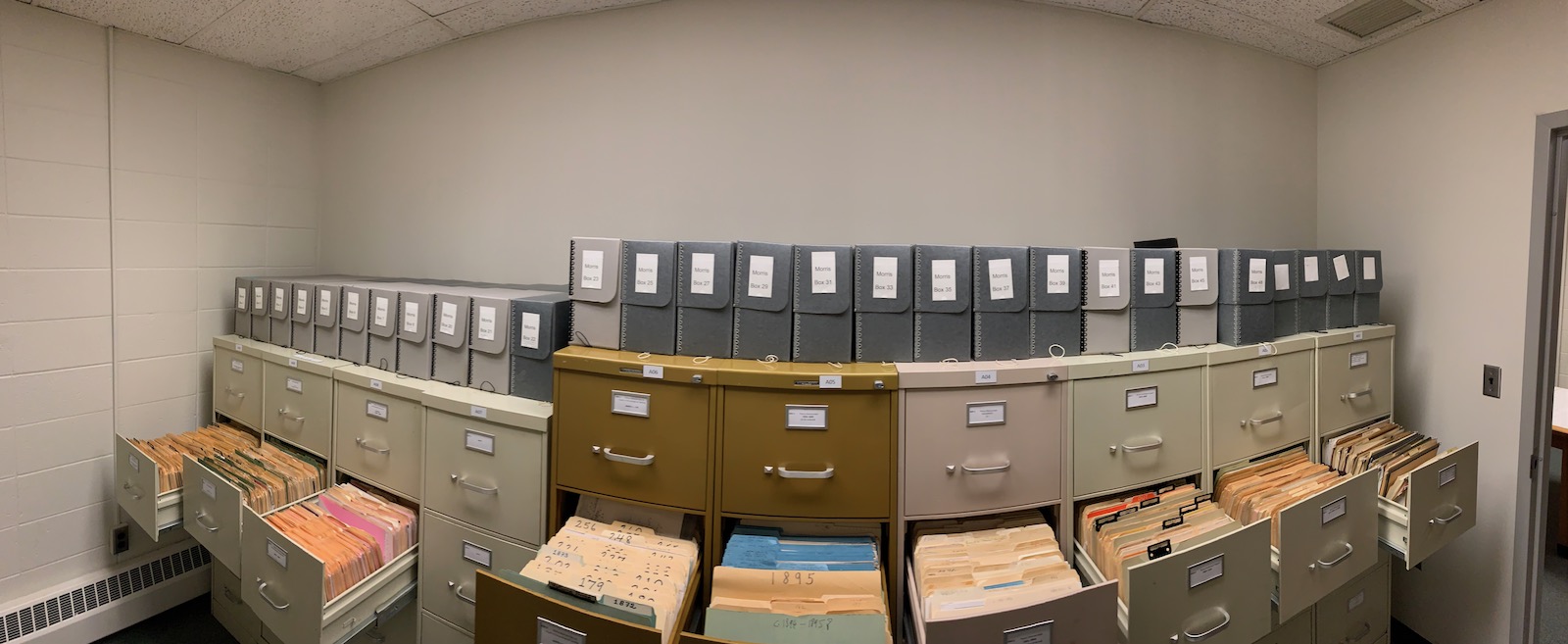
Panoramic view of room with PEP resources and Charles W. Morris archives
Both the IU School of Liberal Arts Office of Development and External Affairs and the Indiana University Foundation are committed to the 15M Endowment Campaign. They ensure its integrity by shepherding all donations to the Peirce Project Endowment Fund, keeping track of donors, certifying and sending receipts for tax purposes, advising donors about the various strategies at their disposal, and investing donations optimally and wisely. You may click either Peirce’s image, the name of the fund, or the “Give Now” button below to be directed to the IU Foundation donation site.
The Peirce Project Endowment Fund receives all donations made out to the 15M Campaign. Monies received are invested by the IU Foundation in order to provide an annual income to the Peirce Project. The Project uses that income to fund its operational costs (technological and editorial), including but not limited to salaries, fringe benefits, space, supplies, technology, cloud server and storage, and related research and scholarly activities.
The Project may not use the endowment’s principal, which shall remain invested in perpetuity. This means that every dollar you give will keep generating funding year after year!
There are several other options for making a donation. Please follow the instructions on the IU SCHOOL OF LIBERAL ARTS’ WEBPAGE.
We would love to talk to you about ways to give to the 15M Endowment Campaign, help make the right choice for you, and of course, thank you for your generosity. Please contact Liz Goodfellow, Executive Director for Advancement in the School’s Office of Development and External Affairs, at lgoodfel@iu.edu or 317-274-1496.
Could they have been contacted in a mediumistic seance, the twenty-five philosophers below from the mid-twentieth century would have agreed to undersign posthumously the 15M Endowment Campaign. Nine of them studied Peirce’s writings assiduously. They and others co-founded the Peirce Society. All corresponded with Charles W. Morris, who donated the better half of his papers—a historically most significant resource—to the Peirce Edition Project. All shared interests akin to some of Peirce’s.

Following their collective putative example, this page will list the names, logos, and URLs of institutes, research centers, societies, and associations that have agreed to support our campaign in one way or another. Institutional and individual donors will be listed as well unless they request anonymity, without donation disclosure.